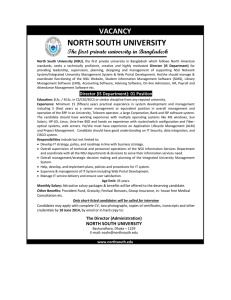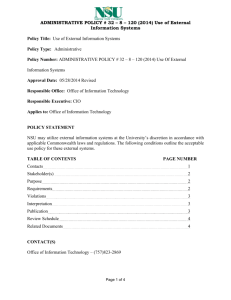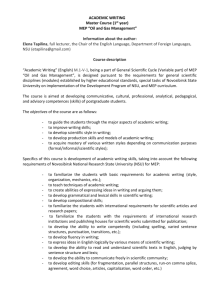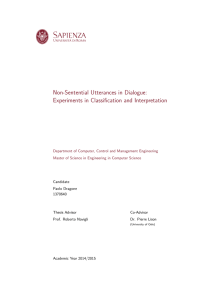Non-Sentential Utterances in Dialogue: Experiments in classification and interpretation Paolo Dragone Pierre Lison
advertisement
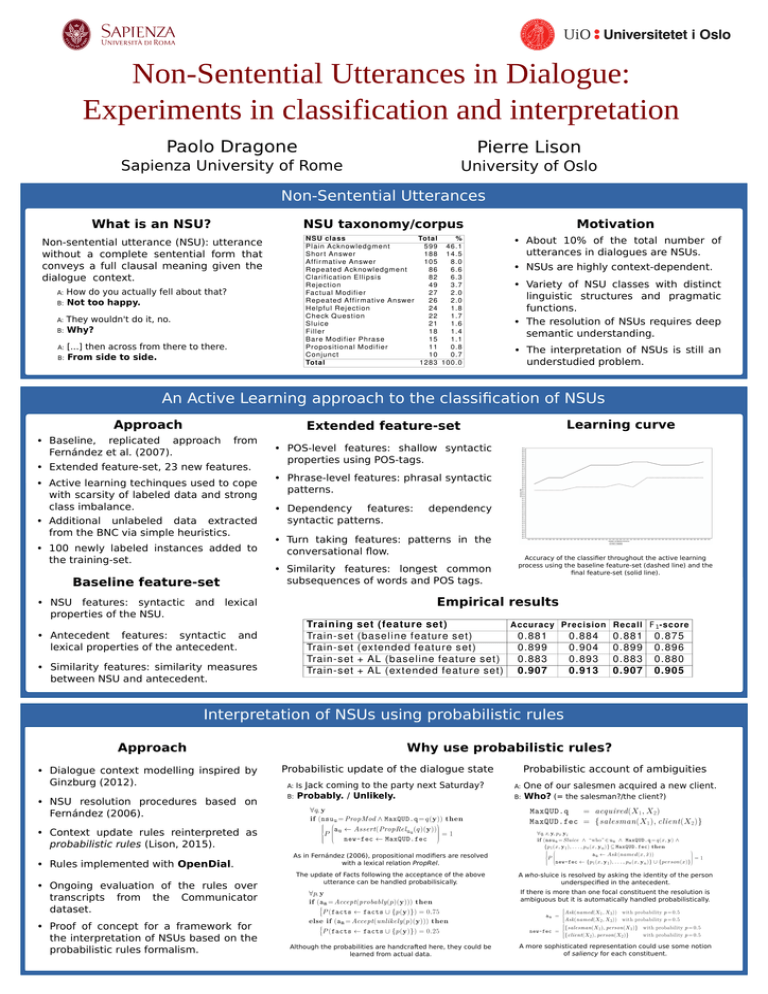
Non-Sentential Utterances in Dialogue: Experiments in classification and interpretation Paolo Dragone Pierre Lison Sapienza University of Rome University of Oslo Non-Sentential Utterances What is an NSU? NSU taxonomy/corpus Motivation Non-sentential utterance (NSU): utterance without a complete sentential form that conveys a full clausal meaning given the dialogue context. NSU class Total % Plain Acknowledgment 599 46.1 Shor t Answer 188 14.5 Affir mative Answer 105 8.0 Repeated Acknowledgment 86 6.6 Clar ification Ellipsis 82 6.3 Rejection 49 3.7 Factual Modifier 27 2.0 Repeated Affir mative Answer 26 2.0 Helpful Rejection 24 1.8 Check Question 22 1.7 Sluice 21 1.6 Filler 18 1.4 Bare Modifier Phrase 15 1.1 Propositional Modifier 11 0.8 Conjunct 10 0.7 Total 1283 100.0 ∙ About 10% of the total number of utterances in dialogues are NSUs. How do you actually fell about that? B: Not too happy. A: They wouldn't do it, no. B: Why? A: [...] then across from there to there. B: From side to side. A: ∙ NSUs are highly context-dependent. ∙ Variety of NSU classes with distinct linguistic structures and pragmatic functions. ∙ The resolution of NSUs requires deep semantic understanding. ∙ The interpretation of NSUs is still an understudied problem. An Active Learning approach to the classification of NSUs Approach Learning curve Extended feature-set ∙ Baseline, replicated approach Fernández et al. (2007). from ∙ Extended feature-set, 23 new features. ∙ Active learning techinques used to cope with scarsity of labeled data and strong class imbalance. ∙ Additional unlabeled data extracted from the BNC via simple heuristics. ∙ 100 newly labeled instances added to the training-set. Baseline feature-set ∙ POS-level features: shallow syntactic properties using POS-tags. ∙ Phrase-level features: phrasal syntactic patterns. ∙ Dependency features: syntactic patterns. dependency ∙ Turn taking features: patterns in the conversational flow. ∙ Similarity features: longest common subsequences of words and POS tags. Accuracy of the classifier throughout the active learning process using the baseline feature-set (dashed line) and the final feature-set (solid line). Empirical results ∙ NSU features: syntactic and lexical properties of the NSU. Training Train-set Train-set Train-set Train-set ∙ Antecedent features: syntactic and lexical properties of the antecedent. ∙ Similarity features: similarity measures between NSU and antecedent. set (feature set) Accuracy Precision Recall F 1-score (baseline feature set) 0.881 0.884 0.881 0.875 (extended feature set) 0.899 0.904 0.899 0.896 + AL (baseline feature set) 0.883 0.893 0.883 0.880 + AL (extended feature set) 0.907 0.913 0.907 0.905 Interpretation of NSUs using probabilistic rules Why use probabilistic rules? Approach ∙ Dialogue context modelling inspired by Ginzburg (2012). ∙ NSU resolution procedures based on Fernández (2006). Probabilistic update of the dialogue state Jack coming to the party next Saturday? Probably. / Unlikely. A: Is B: Probabilistic account of ambiguities One of our salesmen acquired a new client. B: Who? (= the salesman?/the client?) A: ∙ Context update rules reinterpreted as probabilistic rules (Lison, 2015). ∙ Rules implemented with OpenDial. ∙ Ongoing evaluation of the rules over transcripts from the Communicator dataset. ∙ Proof of concept for a framework for the interpretation of NSUs based on the probabilistic rules formalism. As in Fernández (2006), propositional modifiers are resolved with a lexical relation PropRel. The update of Facts following the acceptance of the above utterance can be handled probabilisically. A who-sluice is resolved by asking the identity of the person underspecified in the antecedent. If there is more than one focal constituent the resolution is ambiguous but it is automatically handled probabilistically. Although the probabilities are handcrafted here, they could be learned from actual data. A more sophisticated representation could use some notion of saliency for each constituent.
